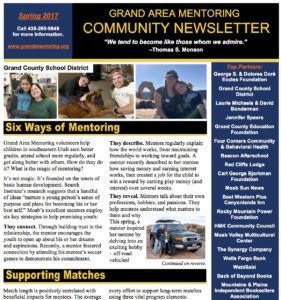Spring 2017 Community Newsletter
Six Ways of Mentoring
Grand Area Mentoring volunteers help children in southeastern Utah earn better grades, attend school more regularly, and get along better with others. How do they do it? What is the magic of mentoring?
It’s not magic. It’s founded on the tenets of basic human development. Search Institute’s research suggests that a handful of ideas “nurture a young person’s sense of purpose and plans for becoming his or her best self.” Moab’s excellent mentors employ six key strategies to help promising youth:
They connect. Through building trust in the relationship, the mentor encourages the youth to open up about his or her dreams and aspirations. Recently, a mentor fostered connection by attending his mentee’s soccer games to demonstrate his commitment.
They describe. Mentors regularly explain how the world works, from maintaining friendships to working toward goals. A mentor recently described to her mentee how saving money and earning interest works, then created a job for the child to win a reward by earning play money (and interest) over several weeks.
They reveal. Mentors talk about their own professions, hobbies, and passions. They help mentees understand what matters to them and why. This spring, a mentor inspired her mentee by delving into an exciting hobby – off-road vehicles!
They notice. Mentors pay attention to find out about their mentee’s interests. They leverage these topics to help the student grow by encouraging essential skills like planning, study, and perseverance. A mentor recently noticed his mentee’s interest in video production. They put together a wonderful short film where they interviewed each other.
They coach. When a mentee identifies a goal, mentors help them work toward it by cooperatively identifying important steps. A student recently talked about wanting to learn how to juggle a soccer ball. His mentor demonstrated different techniques, set incremental goals, and offered a reward for success.
They highlight. Mentors use examples of people from their own lives and from the community to show how successful individuals use knowledge and skill to reach goals. Over the past two months, a mentor has helped her mentee learn how to solve a Rubik’s Cube by introducing him to a practiced puzzler.
Well-trained mentors create opportunities for youth to reach their potential. This is how we bring the inborn talent and interests of youth to their full expression in the future.

[button url=”https://grandmentoring.org/wp-content/uploads/Community-Newsletter-Spring-2017-1.pdf” target=”_blank” style=”red” size=”medium” type=”square”]Download Newsletter [/button]
